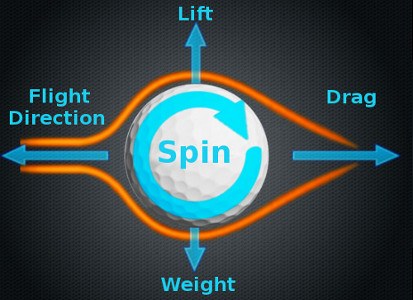
Golf Ball Spin is What the Game is All About
Golf is a game of spin. In fact, most sports that center on a ball are all about the spin that a player is able to impart on that ball. Tennis players use spin to control their shots and make them difficult for the opponent to return – table tennis players do the same. Pitchers in baseball use spin to throw pitches like curveballs and sliders which challenge the hitter to even make contact. A quarterback in football spins the ball as fast as he can in order to help it spiral through the air and arrive perfectly in the hands of the receiver. No matter what game you are talking about, it is safe to say that spin is a major factor when a ball is involved.
| Golf Ball Model | Golf Ball Spin Rate | Model Review |
| Bridgestone TOUR B XS | High | |
| Bridgestone TOUR B X | High | |
| Bridgestone TOUR B RX | High | |
| Bridgestone TOUR B RXS | High | |
| Bridgestone Laddie Extreme | Low | |
| Bridgestones New e6 Lady | Low | |
| Bridgestone Series e6 & e6 Ladies | Mid | |
| Bridgestone e12 Speed Golf Ball | Mid | |
| Bridgestone e12 Soft Golf Ball | High | |
| Bridgestone Precept Powerdrive Golf Ball | Mid | |
| Bridgestone Tour B330 | High | |
| Bridgestone Tour B330-S | High | |
| Bridgestone Tour B330-RX | High | |
| Bridgestone Tour B330-RXS | High | |
| Bridgestone e5 | Mid | |
| Bridgestone e6 | Mid | |
| Bridgestone e6 SPEED | Low | |
| Bridgestone e6 Soft | Low | |
| Bridgestone e7 | Mid | |
| Bridgestone Lady Precept | Mid | |
| Bridgestone xFIXx | Low | |
| Bridgestone Extra Soft | Mid | |
| Bridgestone Laddie X | Low | |
| Callaway HEX Black Tour | High | |
| Callaway HEX Chrome+ | High | |
| Callaway Limited Edition Chrome Soft "58" | High | |
| Callaway Superhot 70 | Mid | |
| Callaway ERC Soft | Low | |
| Callaway ERC Soft New 2022 | Low | |
| Callaway HEX Chrome | High | |
| Callaway HEX Diablo | Mid | |
| Callaway HEX Hot | Mid | |
| Callaway HEX Hot Pro | Mid | |
| Callaway Supersoft Magna | Low | |
| Callaway HEX Solaire | Mid | |
| Callaway HEX Warbird | Low | |
| Callaways New ERC Soft | Low | |
| Callaway Speed Regime 1 | High | |
| Callaway Speed Regime 2 | High | |
| Callaway Speed Regime 3 | High | |
| Callaway Chrome Soft | Low | |
| Callaway Chrome Soft X | High | |
| Callaway Supersoft | High | |
| Callaway Warbird and Warbird Yellow | Low | |
| Callaway HEX Soft | Low | |
| Callaway Supersoft Yellow | Low | |
| Callaway New Chrome Soft with Truvis Technology | High | |
| Callaway New Chrome Soft Truvis Yellow and Black | High | |
| Callaway New Chrome Soft Yellow | Mid | |
| Callaway Strata Tour Advanced | Low | |
| Callaway Supersoft Pink | Low | |
| Callaway Solaire and Pink | Low | |
| Callaway Superhot 55 Yellow | Low | |
| Callaway Superhot 55 | Low | |
| Cut Blue DC | High | |
| Maxfli Revolution Low Compression | Mid | |
| Maxfli Revolution Spin | Mid | |
| Maxfli U/2 | Mid | |
| Maxfli U/3 | Mid | |
| Maxfli U/4 | High | |
| Maxfli U/4x | High | |
| Maxfli U/6 | High | |
| Mizuno RB566 | Mid | |
| Mizuno RB566V | High | |
| Mizuno RB Tour, RB Tour X | High | |
| Nike 20XI-X | High | |
| Nike 20XI | High | |
| Nike One RZN X | Mid | |
| Nike One RZN | Mid | |
| Nike One Vapor Speed | Mid | |
| Nike Power Distance Long | Low | |
| Nike Power Distance Soft | Low | |
| Nike RZN Black | Low | |
| Nike RZN Platinum | Low | |
| Nike RZN Red | Mid | |
| Nike RZN White | High | |
| Nike RZN Tour ball | High | |
| Nike RZN Speed ball | High | |
| Pinnacle Rush | Low | |
| Pinnacle Soft | Low | |
| Pinnacle Bling | Low | |
| Pinnacle Gold Distance | Low | |
| Slazenger RAW Distance Feel | Low | |
| Slazenger RAW Distance | Low | |
| Snell Golf MTB Red | Mid | |
| Snell MTB-X | High | |
| Snell Golf MTB Black | High | |
| Srixon Q-STAR | Mid | |
| Srixon New Q-Star Tour Golf Ball | Mid | |
| Srixon Soft Feel | Low | |
| Srixon Soft Feel Brite | Mid | |
| Srixon Revamped Q-Star | High | |
| Srixon Q-Star 5th Gen | High | |
| Srixon Soft Feel Lady | Mid | |
| Srixon Trispeed Tour | Mid | |
| Srixon Trispeed | Mid | |
| Srixon Soft Feel | Mid | |
| Srixon Z-STAR SL | High | |
| Srixon Z-STAR XV | High | |
| Srixon Z-STAR | High | |
| Srixon Z-STAR PURE WHITE and TOUR YELLOW | High | |
| Srixon Z-STAR XV PURE WHITE and TOUR YELLOW | High | |
| Srixon Q-STAR XV PURE WHITE and TOUR YELLOW | Mid | |
| Srixon SOFT FEEL SOFT WHITE and TOUR YELLOW | Mid | |
| Srixon Z-Star Spin Skin | High | |
| Srixon Z-Star XV | High | |
| Srixon SOFT FEEL LADY SOFT WHITE | Mid | |
| TaylorMade New Tour Response | High | |
| TaylorMade Soft Response | Mid | |
| TaylorMade TP5 & TP5x | High | |
| TaylorMade Burner | Low | |
| TaylorMade Lethal | High | |
| TaylorMade RocketBallz Urethane | Mid | |
| TaylorMade TP5, TP5 X, TP5 Pix | High | |
| TaylorMade RocketBallz | Mid | |
| TaylorMade SuperDeep | Low | |
| TaylorMade Project (a) | High | |
| TaylorMade New Tour Preferred | High | |
| TaylorMade TP5 & TP5x | High | |
| Taylormade Kalea | Low | |
| Taylormade Distance + | Low | |
| Taylormade AeroBurner-Pro | Low | |
| Taylormade AeroBurner-Soft | Low | |
| TaylorMade New Tour Preferred X | High | |
| TaylorMade Project (s) | Mid | |
| TaylorMade Noodle Neon Matte Red/Lime Green | Mid | |
| TaylorMade Noodle Long and Soft | Mid | |
| TaylorMade Noodle Easy Distance | Low | |
| Titleist AVX | Mid | |
| Titleist DT TruSoft | Low | |
| TITLEIST TOUR SPEED | High | |
| Titleist Tour Soft | High | |
| Titleist’s 2020 TruFeel | Mid | |
| Titleist EXP-01 | High | |
| Titleist DT SoLo | Mid | |
| Titleist NXT Tour | High | |
| Titleist NXT Tour S | Mid | |
| Titleist ProV1 | High | |
| Titleist ProV1 RCT | High | |
| Titleist ProV1x | High | |
| Titleist ProV1x RCT | High | |
| Titleist TruFeel | Mid | |
| Titleist Velocity | Mid | |
| Titleist DT Trusoft | Low | |
| Top-Flite D2+ Distance | Low | |
| Top-Flite D2+ Feel | Low | |
| Top-Flite D2+ Straight | Low | |
| Top-Flite Gamer Tour | Mid | |
| Top-Flite Gamer | Low | |
| Top-Flite XL Distance | Low | |
| Top Flite Bomb | Low | |
| Top Flite Gamer Soft | Mid | |
| Union Green Pindrop | high | |
| Union Green Teebird | Low | |
| Vice Pro Soft Golf Ball | High | |
| Vice Pro Golf Ball | High | |
| Vice Pro Plus Golf Ball | Mid | |
| Vice Tour Golf Ball | Mid | |
| Volvik Vivid Golf Ball | Mid | |
| Volvik Crystal | Mid | |
| Volvik Pro Bismuth | Mid | |
| Volvik Vista iV | High | |
| Volvik S4 | High | |
| Volvik S3 | Mid | |
| Volvik Vista iS | High | |
| Volvik Vista DS 77 | Mid | |
| Wilson Duo Soft+ & Duo Optic | Mid | |
| Wilson Staff Duo Professional | High | |
| Wilson Staff C:25 | Mid | |
| Wilson Staff DUO | Low | |
| Wilson Staff FG Tour X | High | |
| Wilson Staff FG Tour | High | |
| Wilson Staff Fifty Elite | Low | |
| Wilson Staff Zip | Mid | |
| WILSON STAFF DUO URETHANE | Mid | |
| Wilson Staff FG Tour Urethane | High | |
| Wilson Staff Duo Soft Spin | Mid | |
| WILSON STAFF DUO SPIN | High | |
| Wilson Staff Duo Spin | High | |
| WILSON STAFF DX3 URETHANE | Mid | |
| WILSON STAFF DX3 SPIN | High | |
| WILSON STAFF DX2 SOFT | Low |
So, with that in mind, your goal on the golf course should be to gain more control over the spin that you put on the ball. Of course, that is easier said than done. Spin is what is responsible for the dreaded slices and hooks that you are probably familiar with – all golfers are. When used correctly, spin can be used to stop the ball quickly on the green and keep it close to the hole. However, when it goes wrong, such as with a hook or slice, you might not even find your ball when it finally stops flying. The best golfers are the ones who can control their spins consistently and limit the number of times during a round that the ball gets out of their control.
Impact Starts the Action
Golf ball spin is imparted at impact when the ball makes contact with the club face and it launched into the air. 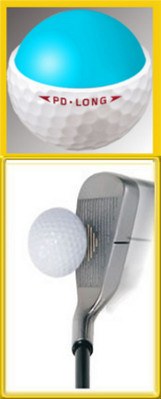 The type of golf ball spin that you put on the ball has to do with the path of the club as it swings through the impact area, relative to the position of the club face. A shot that is struck with a club face which is square to the path of the club should have all backspin and very little – if any – sidespin. If you want to learn how to spin a golf ball back on the green, the first thing you need to do is take away the sidespin. Many players wanting to make their wedges ‘back up’ on the green obsess about how to spin a golf ball more, when really they just need to make better contact and reduce the amount of sidespin that they get on their shots.
The type of golf ball spin that you put on the ball has to do with the path of the club as it swings through the impact area, relative to the position of the club face. A shot that is struck with a club face which is square to the path of the club should have all backspin and very little – if any – sidespin. If you want to learn how to spin a golf ball back on the green, the first thing you need to do is take away the sidespin. Many players wanting to make their wedges ‘back up’ on the green obsess about how to spin a golf ball more, when really they just need to make better contact and reduce the amount of sidespin that they get on their shots.
When you are working on improving the technique of your swing, you are really working on your ability to control spin. As long as you are making solid contact with the ball (not hitting it fat or thin), the result of your shots really comes down to what kind of spin you put on the ball, and what kind of spin you were looking for. If you can successfully match up the spin on the ball with the kind of shot you had planned, great things can happen. While perfection is not possible on the golf course, every player can improve their spin control and their game as result.
Before continuing, please note that the instruction below is based on a right handed golfer. If you are a left handed player and wish to put these tips to use, please be sure to reverse the directions as needed.
Understanding Spin Rate
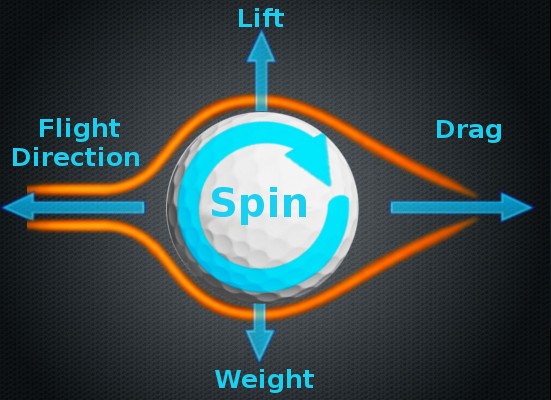
There are two separate aspects to talk about when discussing the spin on a golf ball – spin rate, and spin direction. In this section, we will talk about the spin rate of your shots and how it affects the ball flights you are able to hit. Spin rate, as you probably can guess, is the speed with which the ball is spinning as it leaves the club face. This number usually expressed in terms of RPM’s, or revolutions per minute. So, for instance, a spin rate of 3,000 off of your driver would be a fairly common and reasonable number. It isn’t necessarily good or bad to have high or low amounts of spin – it all depends on the context of the launch as a whole, and what kind of a shot you are trying to hit.
When it comes to hitting a driver, lower spin is generally considered to be better. While you need a certain amount of backspin to keep the ball in the air and get it down the fairway as long as possible, too much is a bad thing. When you spin rate gets too high, you start to hit a ball that ‘balloons’ down the fairway and falls down short of its maximum distance potential. Ideally, you would like to hit a drive that launches relatively high but doesn’t spin too much so it can take a flat, boring trajectory through the air. These are the shots that will travel the farthest, all other things being equal.
Another advantage to a lower spin rate off the tee is the added control you will have over the sideways directions that the ball can travel. Remember, spin can come in the form of both backspin and sidespin, so reducing the overall spin rate should help you to hit the ball straighter in addition to longer. That truly is a win-win situation.
There are a number of options you have when trying to find the right spin rate for your swing off the tee. The first is to get fitted for a driver by a local professional who understands all of the variables that go into building a proper club. You should get matched for the right shaft for your swing, as well as club head loft and some other factors. A good club fitter will be able to bring together all of the information they gather from whatever technology they use to analyze your swing and then recommend a driver that will best compliment your swing. This is not usually an expensive process, and many facilities will refund the charge for the fitting if you purchase a new driver from them.
Getting the right golf ball is another element of the spin rate equation. There are both low spin golf balls and high spin golf balls on the market, so you will need to try out both before picking which one is best suited to your swing and game. Low spin golf balls often feel ‘harder’ when you hit them, especially in the short game. High spin golf balls have a nice, soft feel around the greens for most players, but they can be difficult to control unless you are an accomplished player. Between those two extremes, however, there are plenty of medium spin golf balls that will end up being the right choice for most golfers.
When hitting iron shots, you don’t need to be quite as worried about launch spin rate because you are trying to get plenty of backspin or order to stop the ball when it lands. It is unlikely that you will need to worry about too much spin when striking an iron shot, unless your ball flight is unusually high up into the air (not a problem for most golfers). However, you might find that you are having trouble getting enough spin on your iron shots to control them and hold the green once your ball lands. If this is the case, try the following basic tips –
- Stay balanced in the backswing. A key to imparting a good amount of spin onto the ball at impact is to hit through it with a downward strike. To do that successfully, you must stay on balance and prevent your weight from moving too far to the right during the backswing. Focus on your balance and make sure your center of gravity stays near the middle of your feet even as you swing up to the top of the swing. The golf swing should be rotational, not lateral in nature.
- Hands in front of the ball. It is impossible to execute a clean downward strike on the ball when your hands trail the club head at impact. Make an effort to have your hands lead the way in the downswing as your body rotates toward the target. If you are able to get your hands to the ball before the club head does, you will be in great shape for a downward hit – and plenty of backspin.
Is It Good to Spin Back Your Wedges?
We have all seen it on TV a thousand times, and maybe done it a few times ourselves. 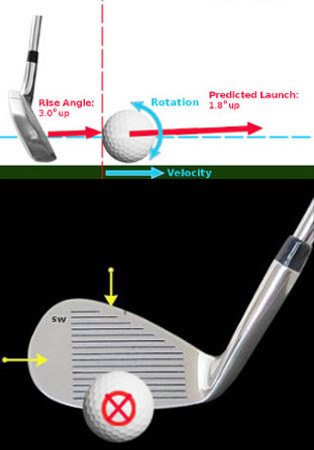 The pros seem to have no trouble hitting a wedge up to the green, letting it bounce once or twice, and then having the backspin take over to bring the ball back toward the front of the green. There is no doubt that this kind of shot looks great, and makes you look like you really know what you’re doing. But is it a good shot to hit?
The pros seem to have no trouble hitting a wedge up to the green, letting it bounce once or twice, and then having the backspin take over to bring the ball back toward the front of the green. There is no doubt that this kind of shot looks great, and makes you look like you really know what you’re doing. But is it a good shot to hit?
That depends. Sometimes it is great to be able to spin the ball back, but other times it can make it very difficult to get the ball close to the hole. In short, the answer is this – it is only good to spin the ball back if you have control over when you do it, and when you don’t. If you spin back every single wedge shot you hit and you can’t stop it, the results are going to leave you frustrated more often than not.
The key here is learning how to manage the spin rate on wedge shots, so you can adjust as necessary based on the situation. To start with, you don’t have to worry much about sidespin on wedge shots – for the most part, any spin that you get is going to be backspin. You might put a little side spin on a wedge shot one way or the other, but rarely will it be enough to cause a big problem. So, that leaves us focused on trying to get just the right amount of backspin for the shot at hand. Too much and the ball might pull back away from the hole – too little, and it might not stop before bouncing over the green.
Backspin, especially when it comes to wedge shots, is created by speed. The more speed you have in your swing at impact, the more spin you are likely to create (assuming you make good contact with the ball). Obviously, then, you can swing softer to generate less spin. For example, imagine you are facing an approach shot where the hole is located in the back of the green. If you fly the ball next to the hole with too much spin, the ball will pull back toward the front of the green and you will be left with a long putt. To get close to the hole, you need to take spin off the shot. Swinging softer is the way to go, which means you will need to take an extra club to carry the distance. So, if you were going to hit a full-power sand wedge to the back hole location, try hitting a softer gap wedge with less spin. The result should be a shot that flies the right distance, and doesn’t have too much spin.
If that isn’t an option that works for you, however, there is another way. Instead of changing clubs, go ahead and use the same club and still give the shot a full swing. This time, move the ball back in your stance so you lower the launch angle of the shot. This isn’t going to do anything to lower the spin rate, but it will prevent the ball from spinning back too much because it will be coming in lower to the green.
This kind of a low wedge approach is a valuable weapon to have in the bag – especially on windy days when you don’t want to float the ball too high into the air.
Picking the Right Ball
As mentioned above, different golf balls offer different spin rates based on the way they are designed and the materials used.  Looking at a golf ball spin chart will help you see which models offer what kind of spin, so you can pick the ones that are going to be a good fit for you. However, looking at a golf ball spin chart is only the start of the process. You also need to test out a few models for yourself before deciding which one specifically should find a spot in your bag round after round.
Looking at a golf ball spin chart will help you see which models offer what kind of spin, so you can pick the ones that are going to be a good fit for you. However, looking at a golf ball spin chart is only the start of the process. You also need to test out a few models for yourself before deciding which one specifically should find a spot in your bag round after round.
So what should you pay attention to when picking the golf ball that has the perfect spin rate for your shots? Consider the following –
- Driver distance. When comparing one ball against each other, look at the total distance that you are able to get off your driver. You will need to hit a collection of shots with each ball before you can have a good sample that represents what each ball can do for your game. Driving distance isn’t the only consideration you should make when picking a ball, but it is a big part of the equation.
- Stopping power. Finding the right combination of a ball that travels long off your driver and still stops quickly can be tricky. However, that is the game you are going to have to play. Observe the ability of each ball to stop fast on the green and then weigh that against the driving distance results.
- Putting touch. Finally, you have to be comfortable putting a golf ball if it is going to last very long in your bag. In fact, this should probably be the first step in the process – eliminate golf balls that you don’t feel good with on the putting green, then proceed to put them through the other tests.
Buying sleeves of golf balls, instead of a whole box, is a good way to test a few models without spending too much money. Also, if you have some friends who play golf, ask them if they would like to trade a couple golf balls that they use for a couple of yours – this way you can both try a new model and see how it performs compared to your current choice. As long as you watch your shots with a careful eye, it shouldn’t take long at all to pick out the golf ball model that you should be using.
Reducing the Dreaded Side Spin
Putting a high rate of side spin on your golf ball is almost never a good thing, unless you are trying to hit a big hook or slice around an obstacle like a tree on the course.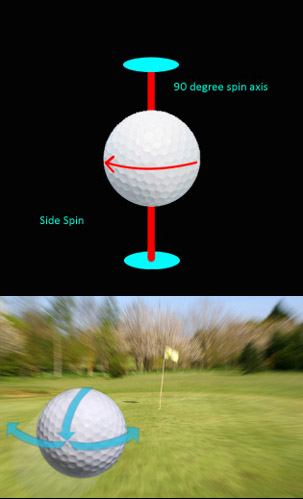 Most of the time, you want to keep sidespin to a minimum so you can hit a nice little draw or fade that heads right for the target. While that is the goal, it is often easier said than done. To reduce side spin, you need to work on your swing mechanics so that the club face and swing path are working together as the club reaches impact. Only when the face and path are heading in the same direction are you going to be able to consistently hit shots that fly mostly straight.
Most of the time, you want to keep sidespin to a minimum so you can hit a nice little draw or fade that heads right for the target. While that is the goal, it is often easier said than done. To reduce side spin, you need to work on your swing mechanics so that the club face and swing path are working together as the club reaches impact. Only when the face and path are heading in the same direction are you going to be able to consistently hit shots that fly mostly straight.
Those of you who are fighting slice spin need to find a way to get the club to work from the inside-out more on the downswing. Slice spin generally occurs when the club gets too far away from the body at the top of the backswing and has to be pulled back in close on the way down just to make solid contact. The result is an impact where the club face is moving across the ball from right to left, and the ball slices off to the right of the target.
In order to correct your slice, work on getting better extension in the backswing. By keeping the club farther away from you during the first couple feet of your backswing, you will have more room to drop it to the inside during the transition. Make sure your body rotates completely during the backswing as well, giving you more space put the club in the right position. Just by thinking about making a ‘wider’ backswing you should be able to quickly improve the slice that you have been seeing.
Golfers who struggle with a hook often have the opposite problem. The club is coming too far from the inside, causing it to move from left to right across the ball at impact. This imparts a hook spin that will almost always cause your ball to finish to the left of the target. As you might guess, the solution to this problem is generally the opposite of the slice. You may be moving the club too far away from your body early in the backswing, making room for a dramatic loop at the top of the swing – and a path that comes significantly from the inside. To solve this problem, try to keep your left arm better connected to your torso during the backswing. It may help to put a glove under your left arm and make some practice swings to get that connected feeling just right. Once you make some practice swings with the glove under your arm, put it away and hit a few regular shots. Hopefully, that hook spin will become a thing of the past.







